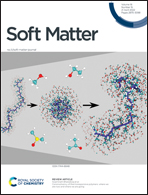A coarse-grained model for capturing the helical behavior of isotactic polypropylene†
Abstract
Understanding the process–property relations of helical polymers using molecular simulations has been an attractive research field over the years. Specifically, isotactic polypropylene still remains a challenge for current computational experimentation, as it exhibits phenomena such as crystallization that emerge on large spatial and temporal scales. Coarse-graining is an efficient technique for approaching such phenomena, although previous coarse-grained models lack in preserving important atomistic and structural details. In this paper we develop a new coarse-grained model, based on the popular MARTINI force field, that is able to reproduce the helical behavior of isotactic polypropylene. To test the model, the predicted statistical and structural properties (characteristic ratio, density, entanglement molecular weight, solubility parameter in the melt) are compared with previous simulation results and available experimental data. For the development of the new coarse-grained force field, a single unperturbed chain Monte Carlo algorithm has been implemented: an efficient algorithm which samples conformations representative of a melt by simulating just a single chain.



 Please wait while we load your content...
Please wait while we load your content...